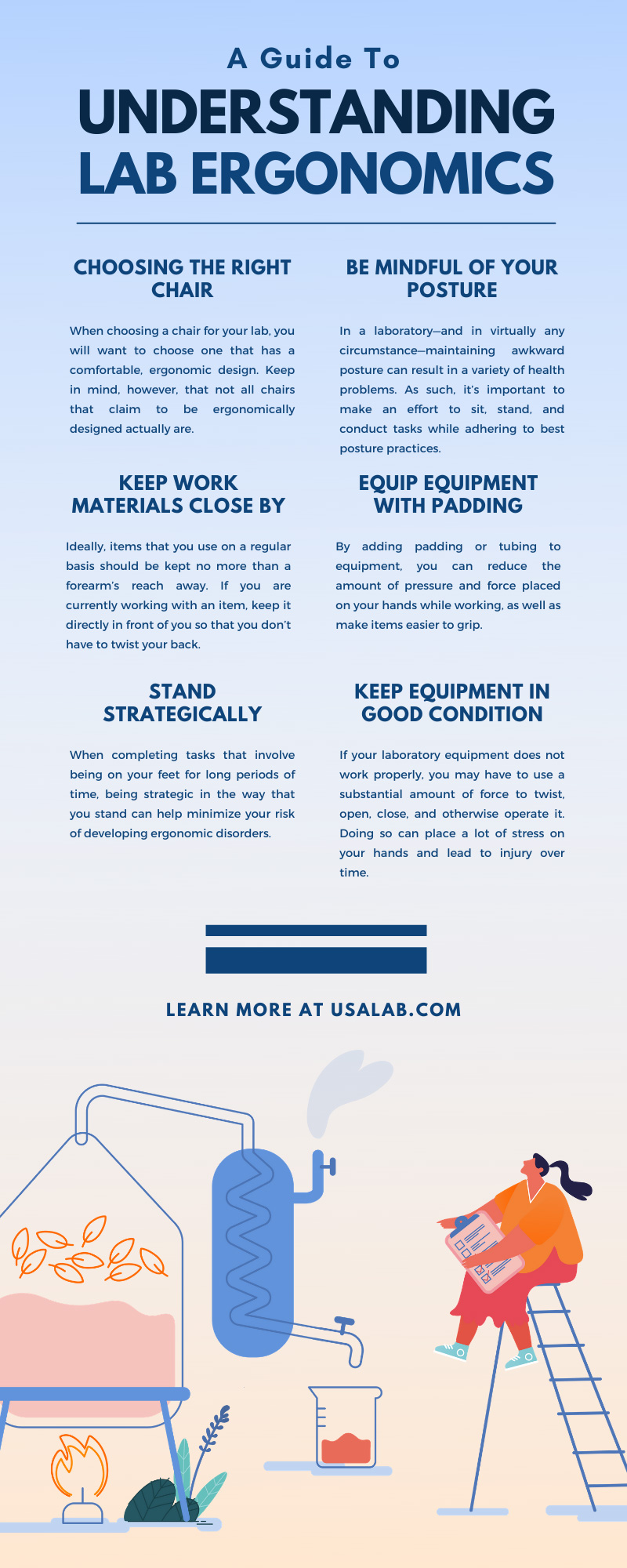A Guide To Understanding Lab Ergonomics
Jun 18th 2021
When thinking of injuries that occur in a laboratory, chemical burns, inhalation of harmful gases, or heat burns may come to mind. However, many people underestimate the potential for ergonomic injuries that prove highly prevalent among laboratory personnel.
Throughout the day, laboratory workers complete a variety of tasks such as excessive lifting of materials or repetitive procedures, which can result in the development of numerous different ergonomic disorders. Some of the most common ergonomic issues among laboratory personnel include tendonitis, carpal tunnel syndrome, wrist ganglion, tenosynovitis, trigger finger, and back injuries. To maintain a healthier workplace and avoid such negative health repercussions, consult the helpful tips laid out in this guide to understanding lab ergonomics.
Choosing the Right Chair
In many laboratories, lab personnel spend a substantial amount of time sitting. In such instances, choosing the right chair can make a huge difference when it comes to preventing ergonomic disorders.
When choosing a chair for your lab, you will want to choose one that has a comfortable, ergonomic design. Keep in mind, however, that not all chairs that claim to be ergonomically designed actually are. To ensure that the chair you choose provides optimal ergonomic benefits, make sure that it has the following features:
- An easily-adjustable seat height
- Ample lumbar support
- Adjustable armrests
- A backrest that supports the natural curve of the spine
- A seat that is wide enough and has enough padding to ensure the comfort of the user
- The ability to rotate
Be Mindful of Your Posture
In a laboratory—and in virtually any circumstance—maintaining awkward posture can result in a variety of health problems. As such, it’s important to make an effort to sit, stand, and conduct tasks while adhering to best posture practices.
When sitting, make sure to keep your back against your chair and adjust the height of your seat so that your feet are flat on the floor. Doing so will provide optimal support for your back and avoid excess strain. In addition, you should keep your wrist straight and your hands at or below eye level.
If you are using a computer, make sure that the screen is at eye-level around an arm’s length away so that you don’t have to tilt your neck up or down. To avoid injury, it is especially important to remain mindful of maintaining proper posture while bending, lifting, or remaining static for long periods of time.
Keep Work Materials Close By
To avoid having to continuously reach or lean over while working in the lab, try to keep your work and all necessary materials close by. Ideally, items that you use on a regular basis should be kept no more than a forearm’s reach away. If you are currently working with an item, keep it directly in front of you so that you don’t have to twist your back. For items that you don’t use as often, an arms-length distance is more suitable.
To keep work materials closer to you, consider using a turntable to store equipment. In addition, you could also consider removing any equipment, drawers, or materials from underneath your workbench so that you can enjoy more leg room and sit more closely to your work. The less that you have to contort, twist, and reach, the better.
Equip Equipment With Padding
Another way to improve the ergonomics of your laboratory and avoid potential health issues is to add padding to your equipment. By adding padding or tubing to equipment, you can reduce the amount of pressure and force placed on your hands while working, as well as make items easier to grip.
Stand Strategically
When completing tasks that involve being on your feet for long periods of time, being strategic in the way that you stand can help minimize your risk of developing ergonomic disorders. For example, using an anti-fatigue mat while working at lab workbenches, at fume hoods, or other tasks that involve standing for a long time will help reduce fatigue. In addition, shifting your weight frequently and wearing shoes that provide ample support will also help reduce the pressure placed on your legs and back while standing.
Keep Equipment in Good Condition
To maintain a healthy laboratory, it’s important to keep your equipment and machinery in good condition. If your laboratory equipment does not work properly, you may have to use a substantial amount of force to twist, open, close, and otherwise operate it. Doing so can place a lot of stress on your hands and lead to injury overtime. As such, you should make an effort to properly maintain your laboratory equipment so that you can use the lightest amount of pressure possible while utilizing it.
Break Up Your Workflow
The next tip on our guide to understanding lab ergonomics is to break up your workflow when possible. A large cause of ergonomic disorders while working in a lab is engaging in highly repetitive tasks. By completing the same tasks over and over again on a daily basis, you run the risk of developing a repetitive stress injury. Also known as a repetitive strain injury, such health issues refer to the steady buildup of muscle, tendon, and nerve damage which occur as a result of repetitive motions.
One of the best ways to avoid incurring repetitive stress injuries is to take short, frequent breaks. Ideally, you should try to take a five minute break from continuous activity every 20 to 30 minutes. However, if you already suffer from a repetitive stress injury, you may need to take more frequent, longer breaks. While it may prove challenging to remember to take a break or to pull yourself away from your work, doing so for just a short period of time can make a large difference in your overall health and wellbeing. If you don’t have the option to take such frequent breaks, at least try to make an effort to vary your activities or change up your working position.
USA Lab Equipment is an industry-leading provider of high quality new and used laboratory equipment. From lab extraction equipment to glassware, we offer a wide range of competitively-priced equipment to keep your lab running smoothly and efficiently. To learn more about our products, contact us today.


